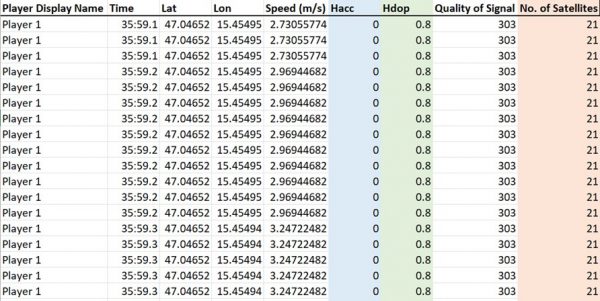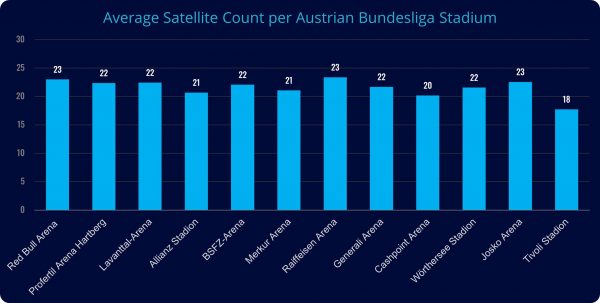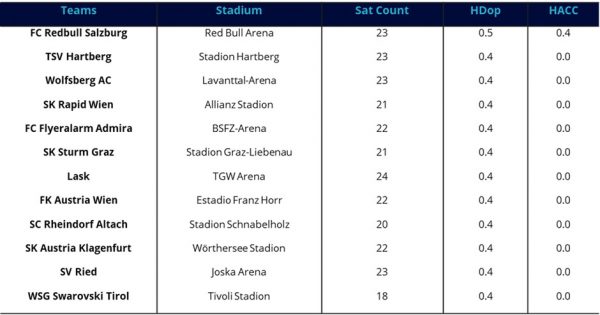
24 Jun Stadium Data – An Austrian Bundesliga Report
INTRODUCTION
With the STATSports Apex device using the latest Global Navigation Satellite System Technology (GNSS).
This enhances the quality of data captured in challenging environments, such as semi-enclosed stadiums or high residential/commercial complexes where signal reception may be compromised.
APEX works off GNSS which can communicate with multiple satellite systems (e.g., global positioning system (GPS), GLONASS, Galileo, and BeiDou) simultaneously, thus providing more accurate positional information.
Regional Satellite-based Augmentation Systems (SBAS) further improves the accuracy and reliability of GNSS information by correcting signal measurement errors and providing information about its accuracy, integrity, and availability.
SBAS uses GNSS measurements taken by accurately located reference stations deployed across an entire continent [1].
For regular GPS Systems that are available commercially, architecture/infrastructure in and around stadium locations can present problems for the accuracy of data captured as well as the calculation and transmission of live data.
Johnston et al. demonstrated significant discrepancies between GPS providers when used in challenging stadiums determined by the mean number of satellites connected during match activities [2].
The same study showed that APEX, powered by augmented GNSS, connected to an average of 17.7 satellites during NRL games compared to another wearable data provider, powered by single constellation GPS, which recorded an average of 10.5 satellites in AFL match-play.
This insight intends to demonstrate the APEX devices ability to deliver the most accurate, consistent, and reliable data in challenging stadium environments in the Austrian Bundesliga.
Methodology
Data was provided by an Austrian Bundesliga team for a total of twenty games that included each team currently in the topflight of Austrian football (21/22 season).
A sample of 16 players were taken from each game. All primary positional groups were covered including defenders, midfielders and forwards to ensure any potential variation between positions was accounted for in the analysis.
Each player was equipped with an Apex GNSS Device. Before the start of each match, the units were switched on approximately 20 minutes prior to the warm up.
This device was worn in a custom fit garment provided by STATSports. The same device was worn by the same player throughout the season to minimize inter-unit variability.
The quality of the data was determined by recording the horizontal dilution of precision (HDOP), horizontal accuracy (HACC), and the number of satellites.

Figure 1: Raw data extended file extracted from Sonra highlighting HACC, HDOP and number of Satellites
HDOP – Dilution of Precision is a term used to describe the strength of the current satellite configuration, or geometry, on the accuracy of the data collected by a GPS or GNSS receiver at the time of use.
HDOP is a factor in determining the relative accuracy of a horizontal position [4]. With GPS receivers, when satellites are grouped together in the same general area of the sky, the satellite geometry is considered to be weak (higher DOP value).
When satellites are evenly spread throughout the sky, their geometry is considered strong (lower DOP value). Thus, the more satellites available spread evenly throughout the sky, the better our positional accuracy will be (and the lower the DOP value).
HACC – Represents the error of measured position compared to the absolute position of the receiver, projected in the horizontal plane. In APEX, HACC is represented by a number between 0 and 7. Values below 1 are considered military level (less than 0.5m error), values below 5 are good (less than 2m error).
Number of Satellites – The total number of satellites used in the calculation of the unit’s position. The data used for analysis accounts only for players who participated in the full game, with all data generated during the half-time period being excluded from the analysis.
The satellite information associated with each player’s positioning throughout the session was logged at a frequency of 10Hz. The Raw Data Extended file (Figure 1) was exported from Sonra and analysed in Microsoft Excel where descriptive statistics were calculated and reported as an average.
Findings and Results
Figure 2 shows a comparison of the average satellite count for a single game in each of the Austrian Bundesliga stadiums. The stadium that reported the highest average number of satellites (23.38) was the TGW Arena, home of Lask.
The stadium that reported the lowest average number of satellites (17.74) was Tivoli Stadion, the home of WSG Swarovski Tirol. Although the lowest value recorded, this value can still be considered extremely good, and users can have confidence in the integrity of the data collected. The Average number of satellites across all stadiums was 21.56 ± 3.19.

Figure 2: Average Satellite count per Austrian Bundesliga Stadiums.
The data in Table 1 shows how each stadium has performed as determined by our three previously identified satellite related metrics.
Eleven of the twelve stadiums in the league reported 0.4 HACC and 0 HDOP values respectively. The average HACC and HDOP values across all Austrian Bundesliga Stadia were 0.04 ± 0.4 and 0.41 ± 0.1.
Both of which are recognised as military accepted levels of accuracy. No significant differences were found when comparing the satellite quality data across each of the primary positional groups.

Table 1. Comparison of the Average HACC,HDOP and No. of Satellites in Austrian Bundesliga Stadiums.
Conclusion
STATSports Sonra Software allows users to export the raw data via the standard Raw Data and extended Raw Data exports, this opens opportunities for user the to analyse and manipulate their data whatever way they choose without restriction.
The CSV format of the export facilitates importing to any number of other software programmes enabling more in-depth analysis or visualisation of the data.
As can be seen from the results, the APEX device provided accurate and reliable data, as determined by the average number of satellites, HACC and HDOP values, throughout 12 Austrian Bundesliga stadiums.
Future research aims to investigate stadium data quality across different sports and in different regions around the world. STATSports are, and will continue to be, committed to data transparency with data collected using our APEX system.
Client Testimonial
“STATSports Apex units along with the Sonra software have provided us with accurate and reliable data over the past two seasons throughout Europa League and Austrian Bundesliga campaigns.
Using the Apex units on a daily basis in all training and matches gives us a better understanding of match day demands, how we can overload the players in a controlled way to exceed match demands yet minimise the risk of injury.
Access to live, accurate data allows coaching staff to make confident, data informed decisions while also allowing instant feedback to players helping to support our playing style.
Integrating the physical data with our video data has provided us with a valuable dimension of analysis in terms of tactical principles and playing style.
Partnering with STATSports has allowed us to accurately monitor training load and develop physically robust players ready for the demands of match day across all competitions.”
- Marco Angeler – First Team sport scientist (SK Sturm Graz)

References
- Geography, G. (2019). GPS Accuracy: HDOP, PDOP, GDOP, Multipath & the Atmosphere. Retrieved June 17, 2020, from Remote Sensing website: https://gisgeography.com/gps-accuracy-hdop-pdop-gdop-multipath/
- Johnston, R. D., Thornton, H. R., Wade, J. A., Devlin, P., & Duthie, G. M. (2020). The Distribution of Match Activities Relative to the Maximal Mean Intensities in Professional Rugby League and Australian Football. Journal of Strength and Conditioning Research, 1. https://doi.org/10.1519/jsc.0000000000003613
- GNSS, E. (2019). Galileo and EGNOS featured at InterGeo 2019. Retrieved June 17, 2020, from Newsroom website: https://www.gsa.europa.eu/newsroom/news/galileo-and-egnos-featured-intergeo-2019
Author Details
Account Management Dept.
Ruth Montgomery
Account Manager